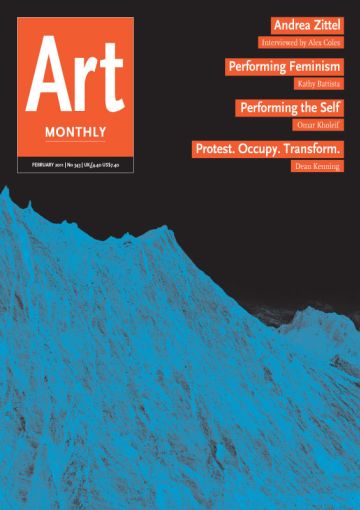Report
Protest. Occupy. Transform.
Dean Kenning reports from the inside on the wave of art school protests
Our second unofficial gallery teach-in took place on 9 December, the evening of the fourth and final demo coinciding with the parliamentary vote on tuition fees – inevitably passed, though with a smaller majority than predicted. I had arrived, together with 200 or so others, in room 43 of the National Gallery to hear ‘Eva Hesse’ and ‘Sol LeWitt’ present talks next to Manet’s Execution of Emperor Maximilian. Someone from the Laboratory of Insurrectionary Imagination handed out A User’s Guide to the Impossible before ‘Douglas Heubler’ split the room into four groups, each given the task of collectively producing the Nomadic Hive Manifesto, a work not completed until well past closing time.
The teach-in may have been a modest gesture, and was certainly more comfortable than being kettled by police in freezing cold Parliament Square until after midnight. The excitement, however, the thing that brought this room of Impressionist paintings alive, came from a reimagined use of our museums and public galleries, one which linked the public value of art to the struggle for free education and, what’s more, to the need for assertive, collective action and disobedience. Not education or protest re-presented in a gallery to be credited as someone’s artwork, but art as a space where real learning and politics can occur.
The action had been planned during the first Long Weekend, held at the Goldsmiths student union building on 4 and 5 December under the organising campaign name Arts Against Cuts. The occupied Slade School of Art building had been the intended venue but security guards were controlling the doors and preventing non-UCL students from entering. It was a weekend of radical art, education and activism, one of several such events coming out of the wave of university occupations that had swept across the country since the first mass demonstration of 10 November. Spread out over two floors of the building, there were intense discussions on the commodification of higher education, the implication of the spending cuts and, more broadly, on economics, philosophical conceptions of community and the politics of art. The Tate Turner Prize and National Gallery teach-ins were proposed, an action paint-bomb group was set up, and the book-bloc workshop produced shields which were mobilised later that week as oversized copies of Adorno and Huxley battled with truncheon-happy riot police. The days that followed saw further London art school occupations of varying intensities at Goldsmiths, Camberwell, London Met and the Royal College.
At the Turner Prize teach-in the following day at Tate Britain, about 150 of us, including students from Chelsea, Slade, Goldsmiths and Kingston, bustled up some back stairs to find ourselves, fairly randomly, in the room of newly hung young British art. Several ‘teachers’ gave talks in front of the great corporate logo that is Damien Hirst’s spot painting, and we all chanted an incantation for JMW Turner to ‘come back from the dead and prize back our art space ... where change brews in the belly of our desire’. Being told politely but firmly that the gallery was shut and we must leave, we refused and simply shifted our collective mass towards the Turner Prize ceremony about to start in the main gallery. Leaderless and chaotic – part of the energy of it – we failed to gain entry through a set of wooden doors before the police arrived. Everyone sat down and, after much chanting, a University of the Arts student union officer and a student from Kingston took turns to strip down to their underwear for life-drawing classes. I had left the building by the time Richard Wentworth emerged to tell protesters that, although everyone supported the students’ cause, they would be ‘considered more stylish’ if they kept quiet now and let the much-delayed prize-giving proceed (a line of argument which failed to convince). There was no predetermined consensus as to whether the Turner Prize was being hijacked simply to make a public protest against the education cuts (and the implications the probable closure of fine art courses would have for our public galleries) or whether the action extended to a more radical challenge to the art establishment and to the competitive culture the Turner Prize represents – the very same culture of competition and privilege about to be foisted onto universities. Nicholas Serota’s endorsement of the students’ position on fees may have seemed a victory to some, but perhaps Turner Prize winner Susan Philipsz’s unfortunate slip in her acceptance speech was prescient when she pronounced, against a chorus of chanting, that ‘education isn’t a right, it’s a privilege’.
The college occupations were not something that occurred while lessons ceased, but were themselves a reimagined artistic and educational alternative in action. In one go, boundaries were dissolved – the borders separating one discipline, subject area or medium from another, one year from another, even one college from another, as well as the divisions between so-called theory and practice, and between students and teachers. Education became a critical problem-posing process necessary for the immediate task in hand, and one which therefore opened up naturally to a much wider curriculum. Something emphasised on the Slade Occupation blog is how valuable the physical space offered at art college is in educational terms – studio space being precisely something which from a marketing outlook becomes a quantifiable commodity, and therefore under threat from more ‘resource-efficient’ courses. So a declaration of what is precious becomes simultaneously a new use of space as a communal forum rather than something to be individually allotted, or fought over (one thinks of the annual scramble for degree show space). In Deleuzian terms it was a question of nomadic distribution rather than monadic division. The profound change that occurred, mirroring the more general mood of the historic moment, was the shift from the individual to the collective, signalled by the proliferating use of the word ‘we’ – an inspiring transformation in an environment that prizes individualised development and the authorship of isolated works. One RCA student spoke of ‘an enormous sense of togetherness and empowerment’. Occupying BA students at the Slade honed particular skills towards the collective good, with mini-groups working on banners, on ‘outreach’ (making contact with other organisations), on Twitter, on video production etc.
It may in fact have been the culture of openness at these relatively more ‘privileged’ art schools – with regular group seminars and less emphasis on processing students through units and modules – which facilitated the move to occupy and the sense of shared ownership which came through that. Also, while the Slade occupation was not ‘militant’ – it was described to me as more like an extended sleepover; no regular activity was disrupted and it ended when a court order was issued – students did become politicised precisely through their communal experience, issuing declarations of solidarity with public sector workers and demanding a London living wage for UCL service staff, who might otherwise have remained a fairly invisible entity. It was, as one Slade student put it, an ‘awakening from apathy’.
Like all substantial communities, the college occupations, teach-ins and other events were formed in clear and meaningful opposition to something – in this case the education cuts and the coalition government. One can imagine a privately run experimental art school operating loosely along the lines of collective production and debate, free of grinding state-imposed assessments, with porous borders between departments, year groups etc. And yet without the political dimension of opposition and resistance, which seeks in the singular instance a universal application (such as the welfare state allows), would not such a school be a parody of the radical and experimental, and, in all likelihood, boil down to a Summerhill-style bastion of eccentric privilege, or else a bargain basement ‘alternative’ attempting to out-price competitors in the new education market (lack of resources masquerading as a radical new DIY programme)? Those like Mike Watson (Polemic AM342), who see the education and arts cuts as an opportunity for both art colleges and artists to escape the bureaucratic marketisation of art in the form of funding and accreditation criteria, are simply playing to the government’s ‘big society’ agenda, turning New Labour tragedy – the artificial marketisation of education through the state (auditing, monitoring, personal development plans, satisfaction league tables etc) – into Tory catastrophe: the total privatisation of education through the withdrawal of the state.
The truth is that for all the moaning about business-model bureaucracies on art courses, the ‘professional development’ skills of personal branding and self-promotion fit extremely well with an ultra-competitive art world beholden to the market. What, I wonder, would independent art colleges alter in this respect except perhaps to eliminate clunky assessment criteria from personal career plans, the better to make a fine art out of the informal commodification of personal relations that comes with the prestige, value-by-association economy that operates in the art world, while exacerbating the entitlement to success of those who already possess money and connections? An effective change in art education requires not just the removal of the business-model assessment culture, but a change in the culture of art. Take the recent Save the Arts campaign. Compared with the grass roots, radical approach of the education protests, the campaign against cuts to arts funding was not only limp (‘cut us don’t kill us’) but distinctly top down and conservative, adopting a two-pronged strategy of art star endorsement and claims for the economic benefit to the nation; in other words, a strategy which, despite its promotion of ‘art for everyone’, fits smoothly with the neo-liberal agenda of status-driven individualism and economic profit as the measure of value.
The historical moment of the student protests of winter 2010 is bookended in the public imagination by the breakaway storming of Millbank Tower and the ‘prodding’ of the Duchess of Cornwall – both in their own ways an irruption of the real into a media-generated spectacle of normality at a time of the most brutal, ideologically driven attack on the population. The stakes could not be higher. What John Beagles has called the ‘incomprehensiveness of art education’, that is the increasingly homogeneous social class make-up of fine art students, will almost certainly be exacerbated under a system where fees are justified according to the market rationale of returns on your investment, ie a higher earning capacity. Will a fine art education become a luxury only the rich can afford? And isn’t the spirit of art education already poisoned when the college is essentially a business, with customers (students) being administered to by service-providers (lecturers)? The substantial challenge the anti-fees movement represents is not simply to education cuts but to a whole neo-liberal agenda whose rot set in a long time ago.
In terms of art the task should not be to defend what already exists – a socially divided, economically driven and hierarchical art system – but to affirm what art might be, a universal, potent and seductive alternative to the status quo. The social case for art and its public funding should be far more bold and challenging. For example, its democratic function in contributing towards a public sphere, drawing on a provocative, critical and imaginative avant-garde lineage to fight the crushing corporate agenda of self-interest propagated by the media. Great art finds common value with collective action in its ability to take us beyond ourselves. Rather than sitting on the periphery figuring out ways to survive, art should be at the heart of the fightback against the total privatisation of existence. This is not a time for ‘opting out’, but for collectively reclaiming what is ours, and for making everything new.
Dean Kenning is an artist and visiting lecturer at Central St Martins.
First published in Art Monthly 343: February 2011.









